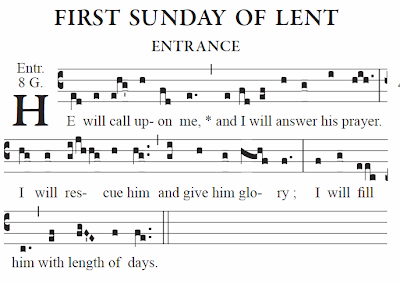During Lent in the Roman Rite, choirs stop singing Alleluia before the Gospel. These days, the most common replacement is called the “Gospel Acclamation” but that is not the tradition of the Roman Rite. As the Catholic Encyclopedia explains, in Lent, the Alleluia is replaced by the Tract. “The name Tract, Psalmus tractus, was given to it, because it was sung straight through without any answer [antiphon] by the choir.”
The Tract makes an appearance in the current General Instruction on the Roman Missal: 62(b): “During Lent, in place of the Alleluia, the verse before the Gospel is sung, as indicated in the Lectionary. It is also permissible to sing another psalm or tract, as found in the Graduale.”
Further, since the Roman Gradual is the normative music of the Roman Rite, one could say that it is clearly preferable to use the tract rather than something else, whatever it may be. (You could take the argument further and perhaps make the case that the Missal acclamation text is primarily structured for reading not for singing, as with the Missal propers in general, and so for singing, one must turn to the Gradual.)
If there is an ordinary form parish somewhere that uses the tract – the full tract from the Graduale, which are very long and very difficult – I’m unaware of it. Or rather: I can think of perhaps two or three cases in the country where this might be done, but the tradition in unknown anywhere else. There are very obvious reasons why. If parishes find it to be a herculean effort to sing Angus Dei, putting together a schola to sing a seven-minute tract in Latin during Lent is highly improbable.
But this post is not about problems; it is about creative solutions. And truly, what I am about to show you is one of the most creative I’ve ever encountered. (Aside: have you noticed that there have been more innovations in integrating the old and new forms of the rite within the last three years than in the previous 40 years combined?)
The solution is to revive the tract by offering it in English set according to a beautiful Psalm tone, so that it can be sung by alternating solo and choir or two choirs or just two singers. Psalm tones are gorgeous and haunting and perfect for Lent. People are not used to hearing them and they are so….Catholic! Yes, the Gregorian original would be better in Latin but that option is clearly not being taken right now and it has been available for many decades. What we need is a way to revive the Tract in the current environment.
Aristotle Esguerra has provided that solution. I gave you
prepared by Aristotle Esguerra, one of the most creative, productive, and brilliant Catholic musicians working today. This are very easy to sing but produce a fantastic result. The text comes through in a clear narrative, which is exactly what Psalm tones are designed to do, and they do so prayerfully and solemnly.
Each of these can be sung by anyone with very little practice. And doing through extends the time before the Gospel, produce a sense of stillness and reflection. It is all the more reasonable to do these within Lent because there is no Gloria, which then allows more time for a different form of music.
This approach also helps single out Lent as a special liturgical time different from the rest. The people will know this and hear this (whereas a short Gospel Acclamation makes Lent seem pretty much like the rest of the year.
This is a way of restoring Roman rite tradition in stages. This is a gigantic first step. If nothing else, if a pastor is squeamish about using this before the Gospel, singers can use this tract during the offertory. At least in this case, the choir is actually contributing to the liturgical structure rather than just being there to “provide music” of some sort to pass the time.
Congratulations to Aristotle for his work here. And a special thanks goes out to him for make this a free download for the whole English-speaking Church. There are some editions of the tracts available in Psalm tones but I believe this is the first to come out in modern English and the first new edition in many decades.
A note on performance, and I suppose that this can’t be said enough. There are two clefs in Gregorian notation, C and F. The half step of the scale occurs just before the clef marking. This way you can go to the piano and pitch it out. Each tones only has four notes so this should not be a problem for anyone. As for rhythm here, the pace should follow the speech pattern you would use in reading, with word accents as the English language would suggest. If you do those things, this will be beautiful, effective, and thoroughly liturgical.




